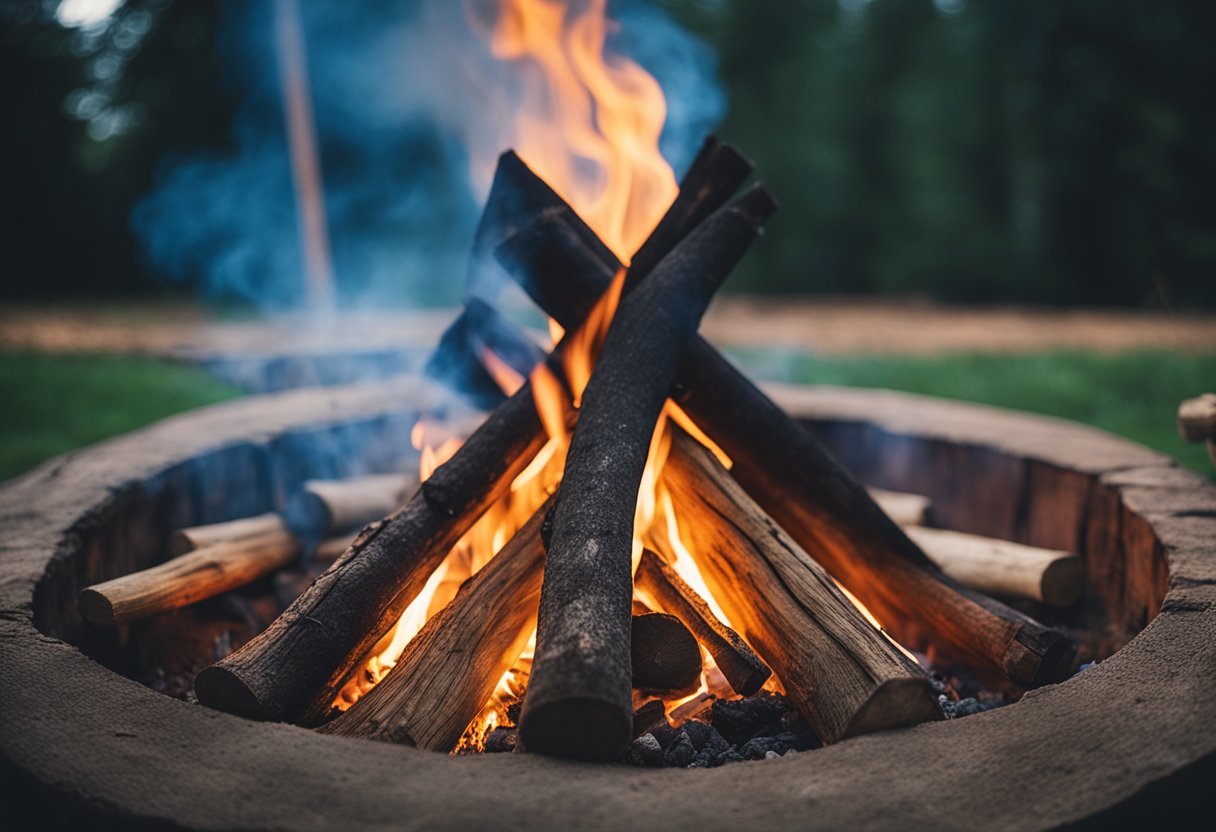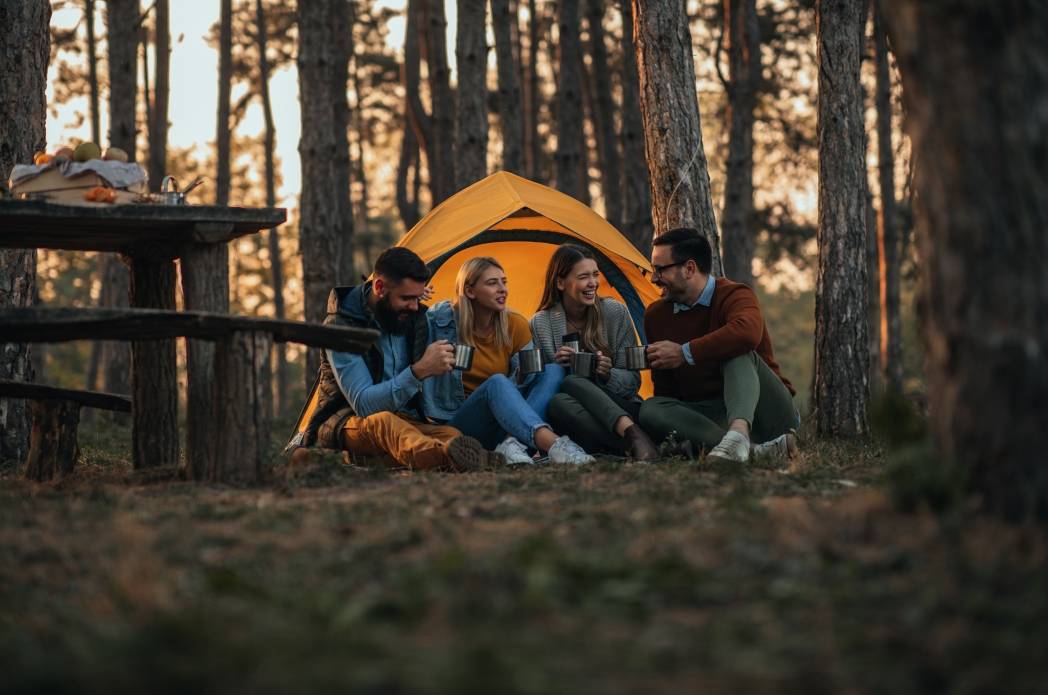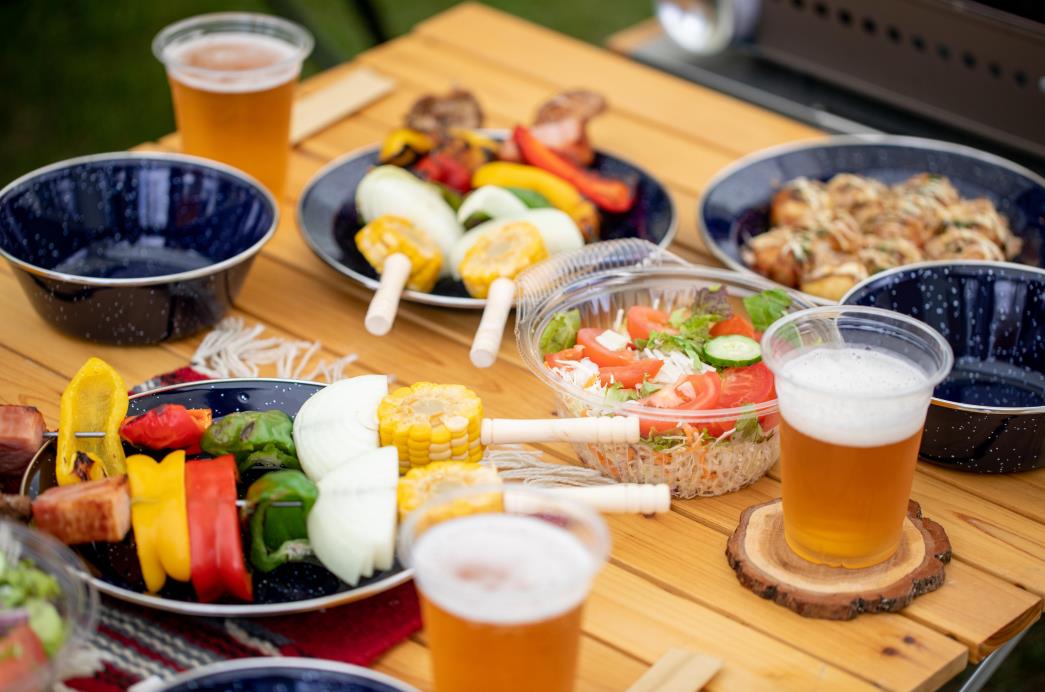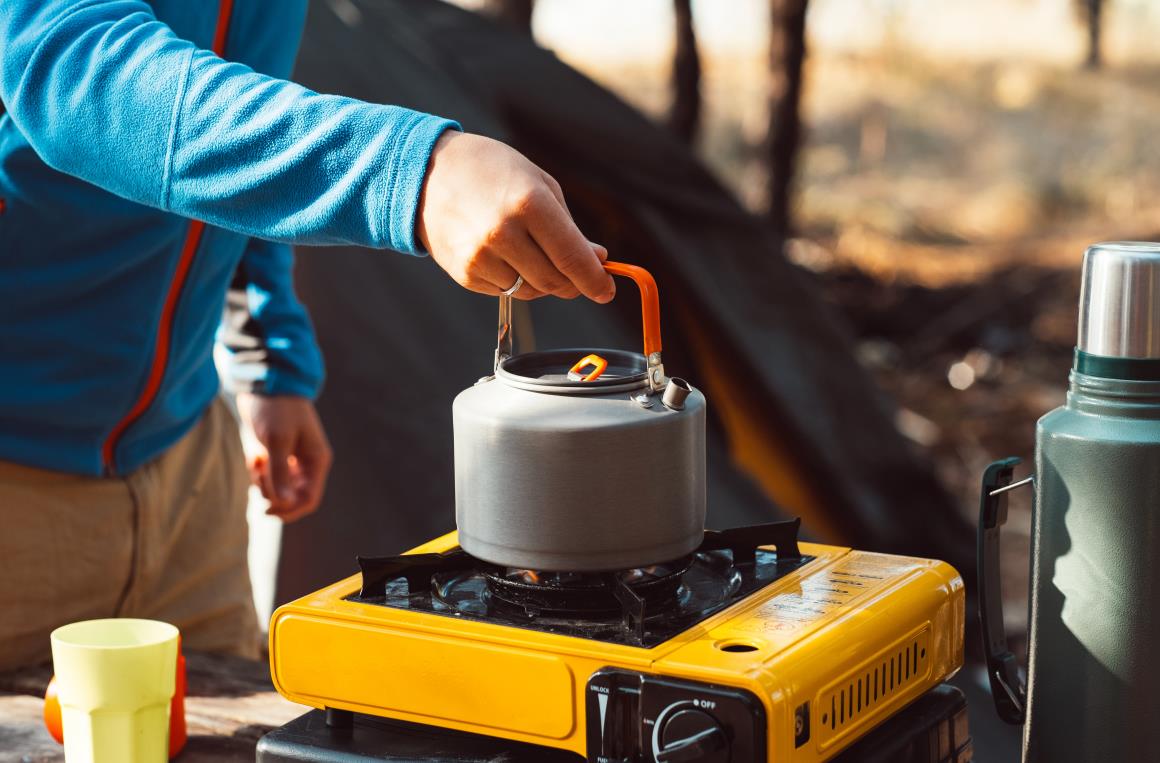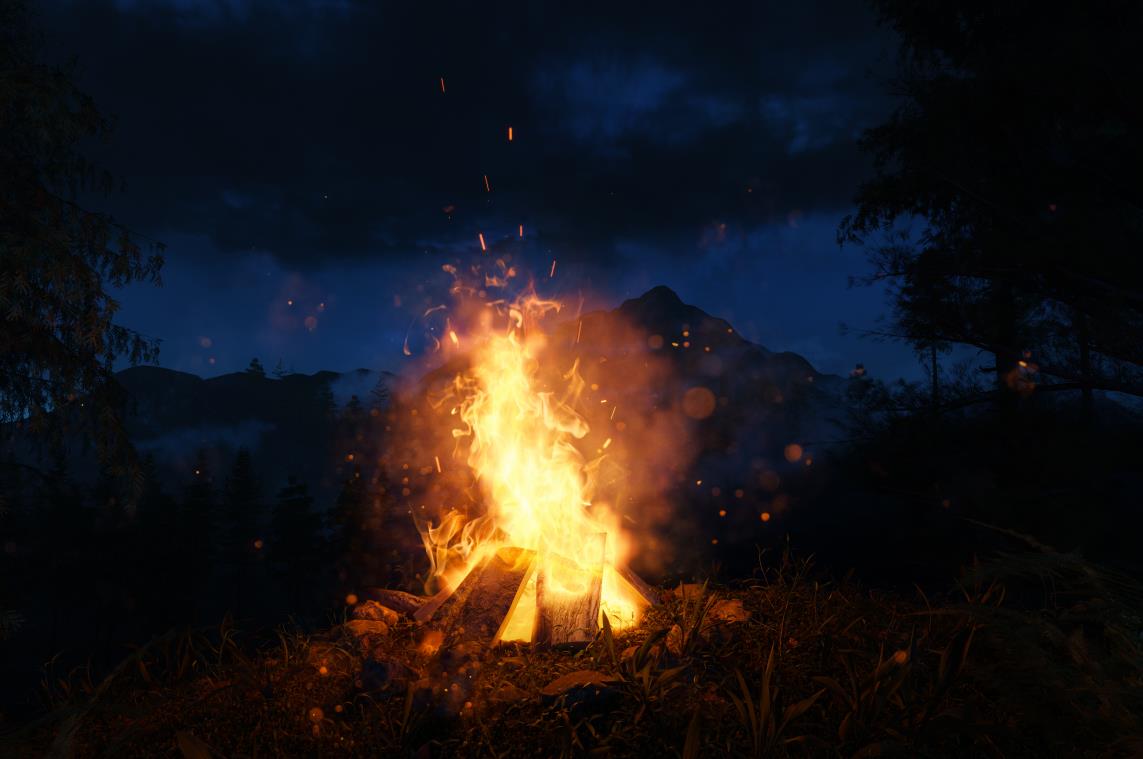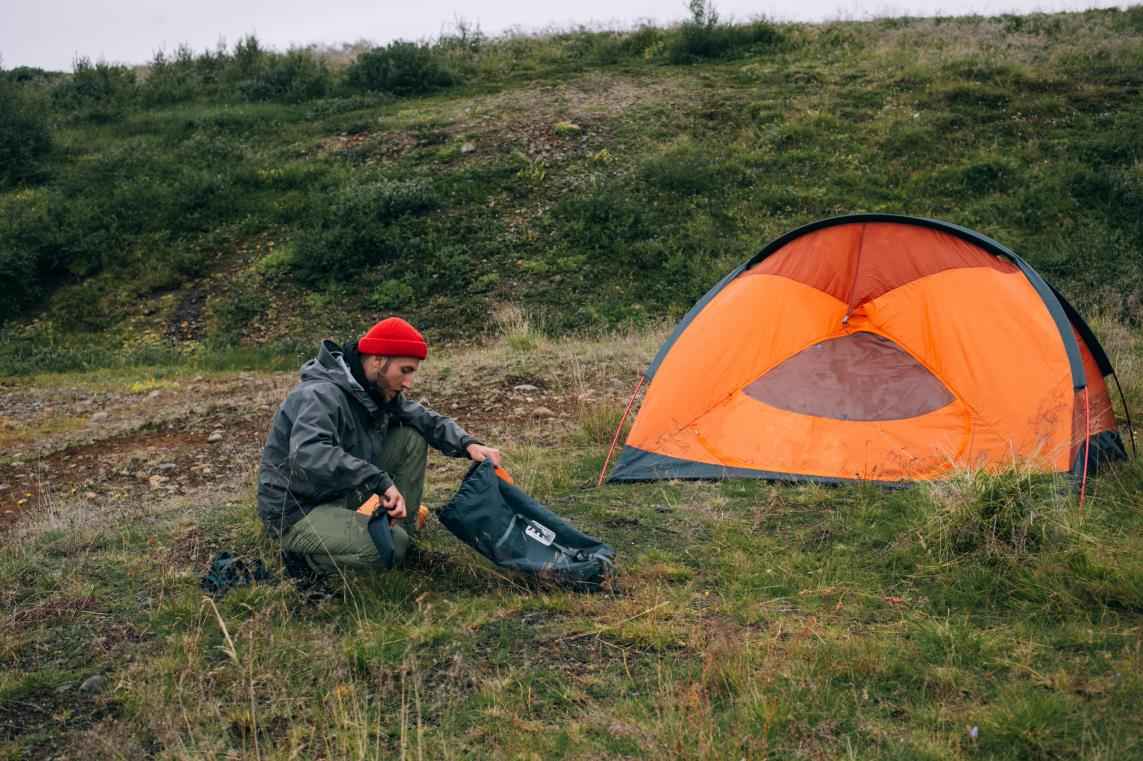After long hours of following hiking trails, fishing, and wildlife watching, all campers look up to is a delicious blowout. A well-cooked meal provides a way to nourish the body, boost morale, and satisfy cravings, adding to the overall enjoyment of the camping experience.
However, cooking while camping mandates a different approach than cooking in a traditional kitchen. With limited resources, equipment, and space, you must prepare effectively and be creative for the activity to succeed.
To cook while camping, you must have the right gear. Such involves a camping stove, a compatible fuel source, the right cookware, and utensils like spoons, knives, and forks. Most importantly, you need the food and the right ingredients. You can choose meats like steak and chicken or one-pot and foil-packet meals. The next step is to fire up your stove and follow a recipe to cook a delicious meal.
This article will teach you how to cook while camping. We’ll discuss the essential tools needed and offer tips on the same. The article will also cover how to clean your tools after cooking in the wild and provide several recipes for some everyday camping meals.
Table of contents
Preparation
Preparation is next to readiness. This is the first and most essential part of any camping activity. Unlike cooking in a traditional kitchen, the wilderness doesn’t give you access to all the ingredients and tools needed. You have to carry them with you, and while it may seem like a standard first step, we are humans, and we tend to forget even the basic things.
During the preparation step, it’s best to list everything you need. Double-check each item down to the spoon and pepper grinder as you pack. It’s also best to have another plan if equipment fails to work as desired or the weather doesn’t cooperate.
For instance, if you intend to cook raw chicken and it starts to rain uncontrollably, you’d be better off withof with a propane stove and tarp to protect yourself and the fire from the harsh weather. It’s also best to carry some ready-to-eat snacks like roasted pumpkin seeds, apple chips, and campfire popcorn.
Essential tools for camp cooking
The right equipment ensures you can cook efficiently and safely in a remote outdoor setting. While the type of food you intend to cook can dictate the tools to carry, some are too essential, and you’ll need them no matter what.
Below are the essential tools for camp cooking you need to consider.
Camping stove
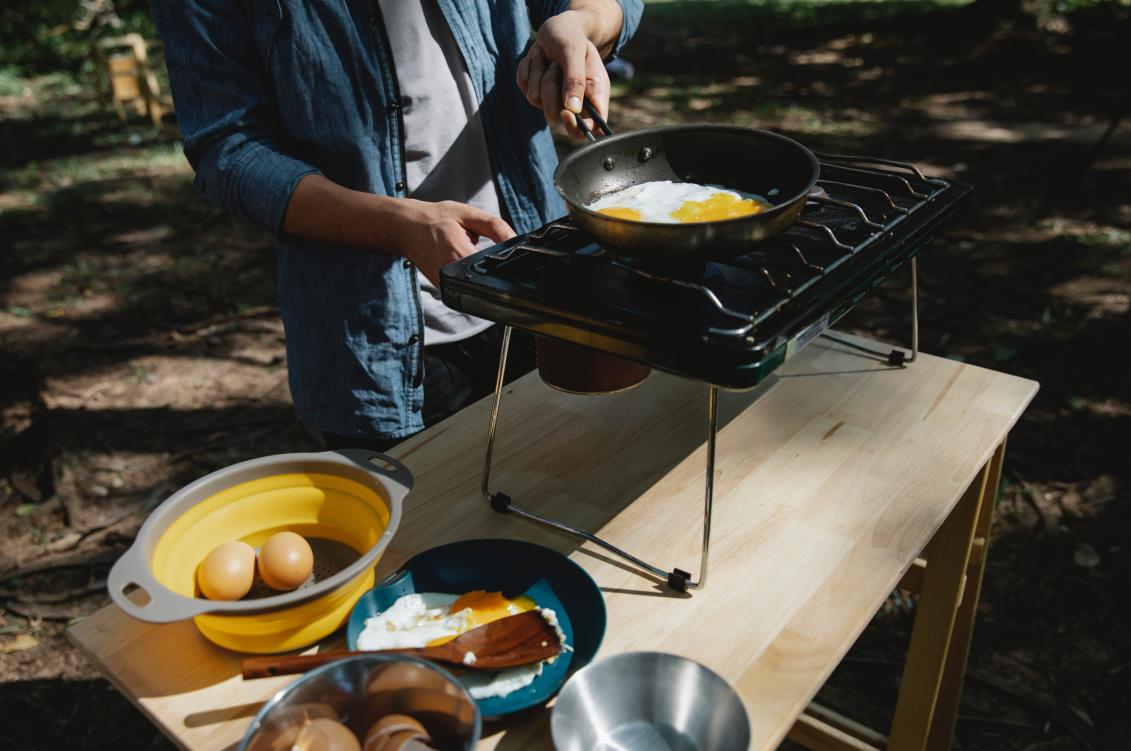
A camping stove is a must-have for any camping trip unless you plan on cooking over an open fire. While the latter is an excellent option, and to be honest, it makes the food more delicious because of the smoky flavor, it’s hard to regulate the temperature. For instance, you can add wood to the fire and cause it to flare up and burn your meals or reduce the wood, and the temperature won’t be enough to cook your food properly.
A camping stove can save you from this hustle. You can regulate the temperature by adjusting the knob as desired. Several of these stoves are available on the market, and choosing one that’s ideal. Here are some popular options:
- Canister backpacking stoves: Designed to be lightweight and compact for easy packing and transport on backpacking trips. These stoves run on small fuel canisters, producing a narrow flame ideal for cooking small meals and boiling water.
- Standard propane campground stoves: They come in various sizes, from larger two-burner stoves with built-in windshields to small single-burner stoves. While they are easy to use and provide a consistent heat source, some can be heavy, making them ideal for trips where weight and portability aren’t much of a concern.
- Liquid fuel backpacking stoves: These stoves burn on white gas, a highly refined form of gasoline. Unlike propane stoves, they are more versatile because they use various fuels, including kerosene, diesel, and unleaded gasoline. However, they are bulkier and require regular maintenance.
When preparing for an emergency, carrying an alternative fuel source is essential. Such include:
- Solar stoves
- BioLite stoves
A solar stove or oven uses the sun’s power to cook. While it doesn’t produce an open flame nor reach temperatures exceeding 300 degrees Fahrenheit, it’s an ideal heat source for foods requiring longer simmering or baking. So if you plan camping on a sweltering day, a solar stove can be an excellent backup energy source.
A BioLite stove uses leaves and wood twigs to produce an almost smokeless flame and electricity. As such, you can use it to prepare your meals and charge your electronic devices. If you run out of propane or white gas, it’s an excellent alternative because you can easily find wood twigs and leaves. However, they are a bit bulkier.
Cookware and utensils
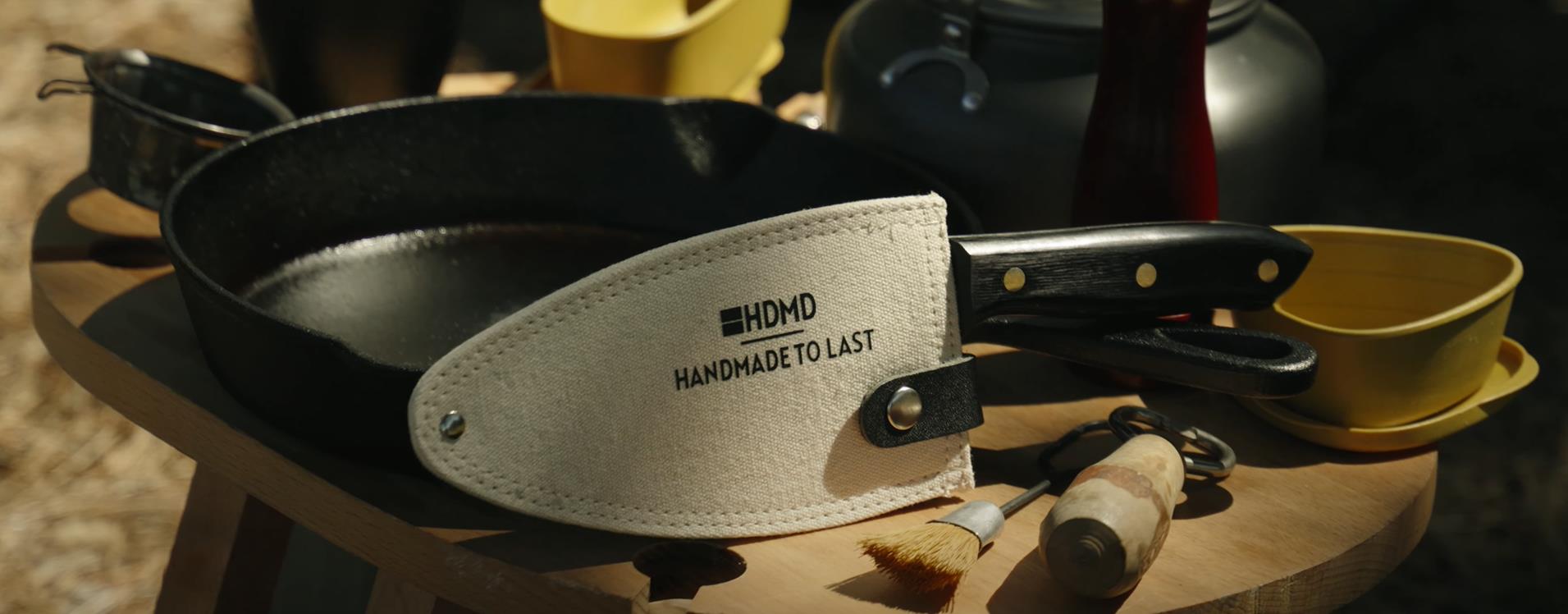
Once an energy source is ready, you’ll need the necessary cookware and utensils. Cookware refers to the pan and pots used for cooking, which feature various materials, including stainless steel, cast iron, non-stick coatings, or copper. If you are car camping, by all means, use the heavy cast iron cookware.
Besides being easy to clean, the material is virtually indestructible, and campers can use it over open flames. Stainless steel is also an excellent option because it conducts heat well and is resistant to corrosion and rust.
However, if you are backpacking, we recommend lighter materials like aluminum and titanium. While not as durable as cast iron, aluminum heats quickly and cooks food evenly. Titanium is strong and durable, with excellent resistance to rust and corrosion. However, titanium cookware is more expensive and takes longer to heat up.
Remember utensils, too. While you can use your in-house kitchen utensils, we recommend purchasing specialized camping ones. Some utensils include tongs, knives, spoons, forks, and spatulas. Buying utensil sets is more cost-effective.
Knives and cutting boards
Knives fall within the utensils category, but discussing this section separately is best because there’s so much to consider when choosing one for camping. Camping knives come in different shapes and sizes, often determined by the intended use. Some of these include fixed-blade knives, folding knives, multi-tool knives, and machetes.
Still, you can use the standard chef’s knife if dedicated ones are out of reach. If so, we recommend the HDMD Utility Chef Knife. This knife comes in a size any chef can handle and offers the versatility the wild demands. You can use it to scale fish, mince herbs, and even carve wood.
Apart from knives, you’ll also need a cutting board. It doesn’t have to be fancy because you aren’t looking to impress anyone at camp. However, it should offer the functionality needed. Always consider the size and material used. Mid-size wooden cutting boards are ideal because wood like acacia lasts longer and is less likely to harbor bacteria.
Handpicked for you
True cutting power in the palm of your hand
Cooler
If you plan on cooking highly perishable items like fish or meat, you’ll need a cooler to store them before the time comes. For longer trips, we recommend carrying a capacious cooler where you can also load up some beverages. Try to freeze everything going into the cooler to ensure they remain fresh for longer, and use resealable plastic bags to save on space.
Planning your meals ahead of time
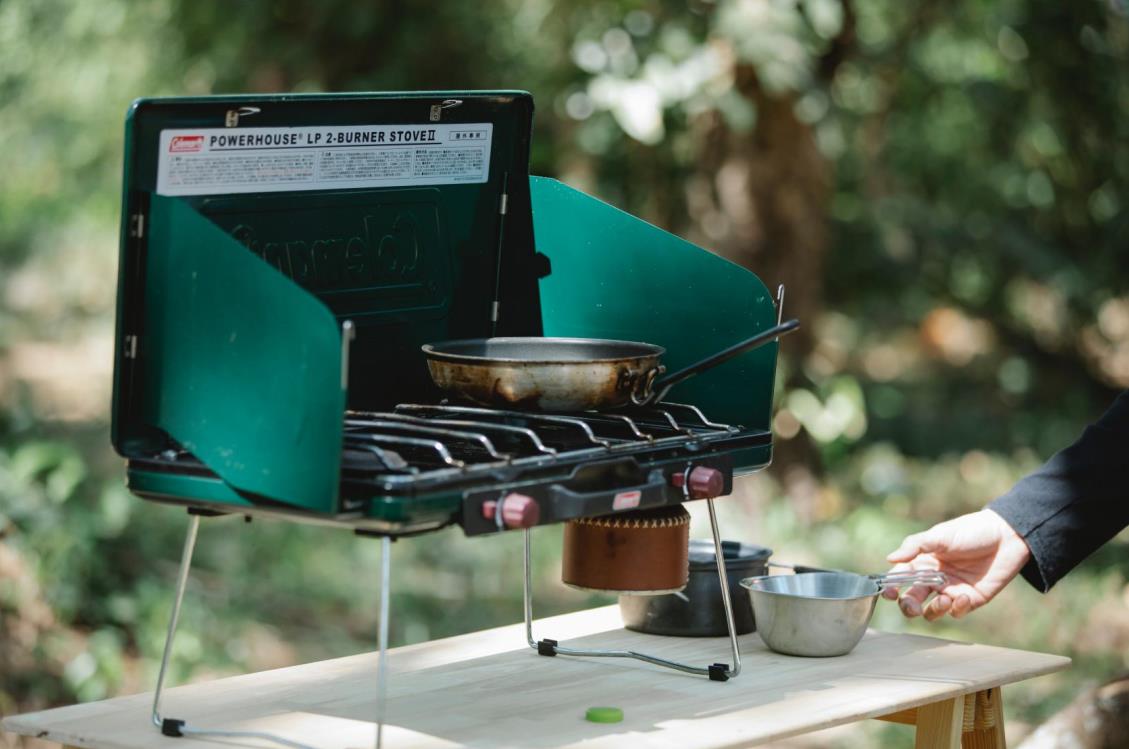
Understanding what to eat and when is integral to the camping experience. Whether you’re car camping or backpacking, planning your meals helps ensure that you have enough food, that you’re getting the nutrients you need, and that you can prepare meals efficiently.
Are you always on the go, or is the trip relaxed?
The level of activity and the type of camping you’ll be doing will directly impact the meals you plan to prepare.
If you’ll be on the go most of the time, choosing MREs that are easy to prepare and cook quickly is essential so you can spend more time enjoying outdoor activities. One-pot meals like stews, chili, and stir-fries are great options, as they require minimal prep and cooking time.
On the other hand, if your camping trip centers around relaxing, it can be fun to plan more involved meals that take longer to prepare and cook. Such meals include grilled meats, roasted vegetables, or even campfire pizzas.
Consider the shelf life of the ingredients
When planning meals for a camping trip, it’s essential to consider the shelf life of the ingredients you’re using. Since you’ll likely be without a refrigerator or access to fresh groceries, choosing meals that don’t spoil quickly is best.
Canned goods, dried beans, rice, and pasta are excellent camping meal options, as they are easy to store and last longer. When selecting fresh ingredients like fruits and vegetables, choose hardy ones that can withstand storage without refrigeration for a few days.
Consider in-between-meal snacks
Don’t overlook the importance of snacks. While you may have planned your breakfast, lunch, and dinner, it’s easy to underestimate the energy you’ll burn while camping. That’s especially true if you engage in physical activities like swimming or hiking.
Packing some in-between-meal snacks is a good idea because it helps keep your energy levels up and prevent hunger between meals. Nonperishable snacks like granola bars, jerky, nuts, and trail mix are excellent options that are easy to pack and store. It’s also good to consider fruits and vegetables like carrots and apples.
Pack proteins that cook fast
Unless you have all the time in the world, you need to pack proteins that cook fast. Protein is essential to any meal. When camping, it’s vital to choose proteins that cook quickly, as you may not have access to a full kitchen setup or a lot of time to spend cooking.
Good options for quick-cooking proteins include thinly sliced steaks, canned fish cuts like tuna or salmon, shrimp, precooked chicken or beef strips, and tofu. You can easily incorporate these proteins into one-pot meals like soups or stir-fries.
Setting up your camp kitchen
Once you have the essential tools and a meal plan, you should set up your camp kitchen. This part ensures you stay organized and all you need is within reach. Here are some steps to set up a successful camping kitchen.
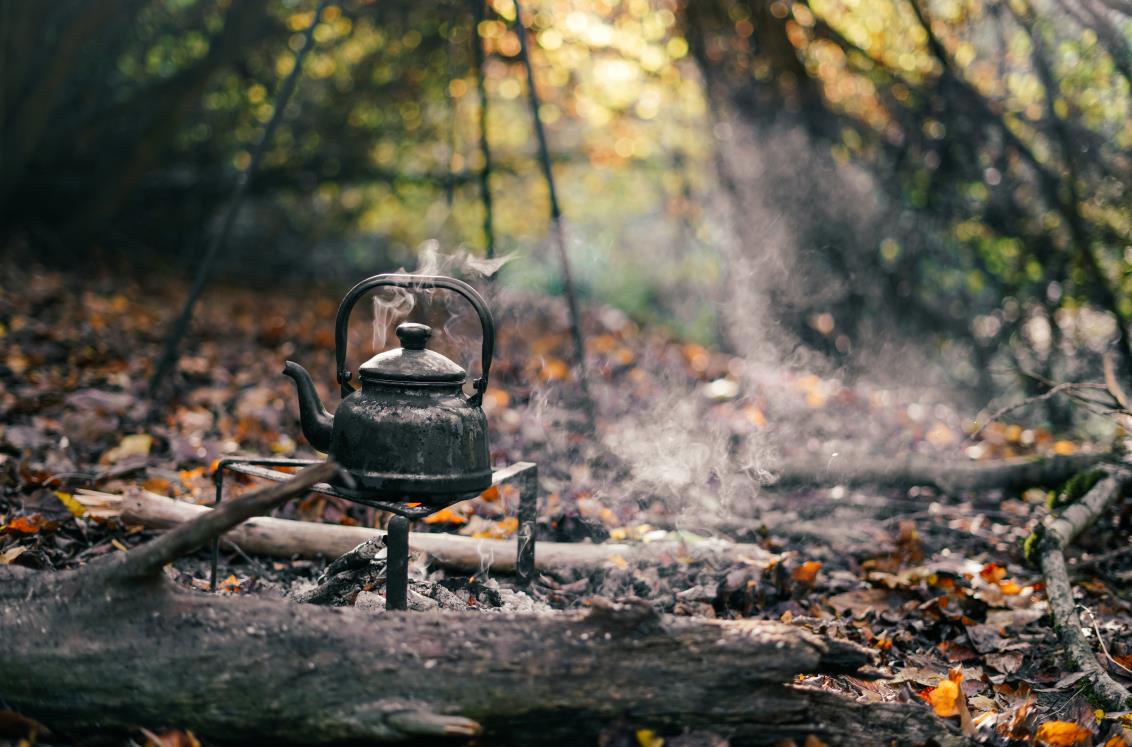
- Choose a flat and level area: Look for a level area near your campsite that you can use as a kitchen area. Clear any shrubs, twigs, and dry leaves from the area before setting up. You can use a hoe to level the ground if there are any hilly patches.
- Set up your stove and portable cooking equipment: Bring a camp kitchen or portable cooking equipment like a stove, grill, or Dutch oven. Ensure the equipment balances well and doesn’t till when you apply force.
- Consider lighting and safety: Ensure proper lighting and safety measures, especially if you cook at night. Bring lanterns or headlamps to light up your kitchen area, and follow appropriate safety protocols when using open flames or cooking equipment.
- Organize your utensils and cookware: Organize your utensils, cooking tools, and equipment to make them easy to access and use. Consider using a plastic bin or tote to store your kitchen supplies. Also, label each item to make it easier to find what you need.
- Set up a food storage area: Set up a separate area for storing your food supplies, like a cooler or food storage container. Doing so helps prevent contamination from other camping supplies.
How to cook while camping
You can use different tools to cook different camping meals. From grilling to boiling, roasting to Dutch oven cooking, foil packet cooking to smoking, campfire cooking to solar cooking, there are endless ways to prepare your camp meals.
Each method has unique benefits and can create different flavors and textures in your food. This response will briefly overview how to cook using different methods.
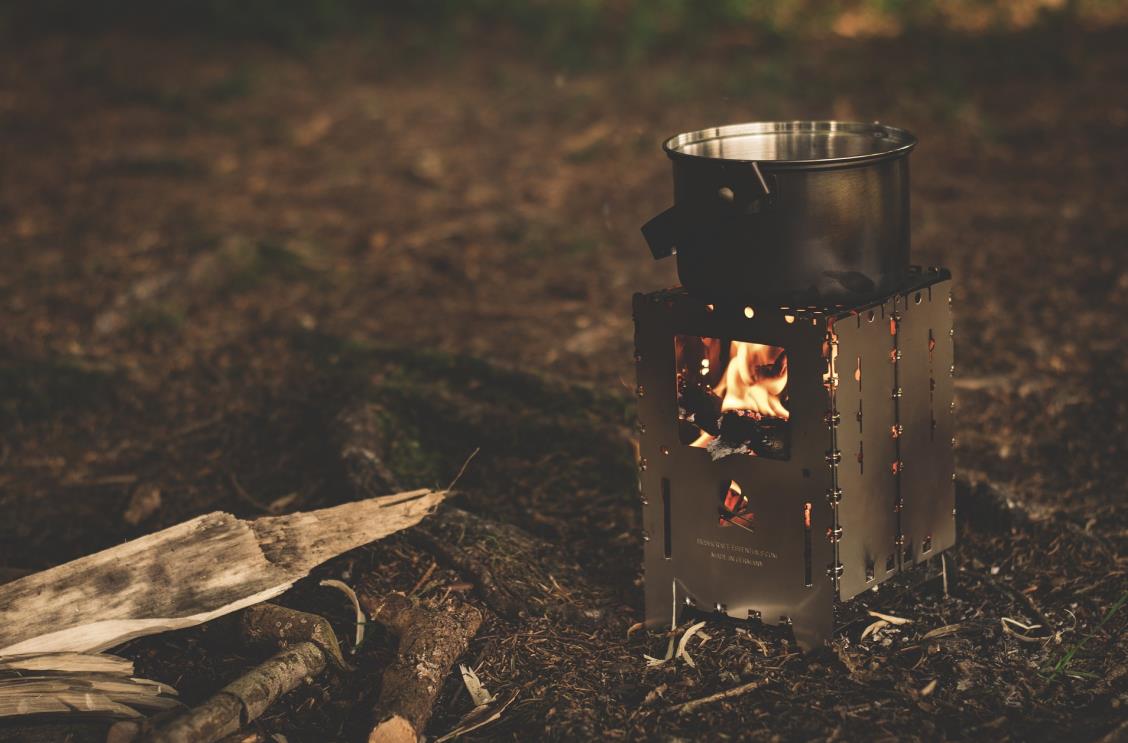
Grilling
- Preheat the grill to medium-high heat.
- Oil the grates and brush the food with oil to prevent sticking.
- Place the food on the grill and cook for the desired time, flipping once.
- Using a thermometer, confirm the internal temperature to ensure the food is cooked properly.
Roasting
- Preheat the oven to the desired temperature.
- Place the food on a roasting pan and season with salt, pepper, or spices.
- Roast the food for the desired time, checking it periodically to ensure it cooks evenly.
- A thermometer checks the internal temperature to ensure the food is cooked properly.
Smoking
- Soak wood chips in cold water for at least 35 minutes.
- Place the chips in a smoker box or aluminum foil pouch with holes poked in it.
- Add the food to the smoker box or pouch over the campfire or portable stove.
- Smoke the food for the desired time, adding more wood chips
Boiling
- Boil water over the campfire or portable stove.
- Add the food and cook for the desired amount of time.
- Use a strainer to remove the food from the pot when it is done.
Foil packet cooking
- Preheat the oven to the desired temperature.
- Place the food and seasonings on a sheet of aluminum foil and wrap it up tightly.
- Place the foil packet on the grill or oven and cook for the desired time.
Dutch oven cooking
- Preheat the oven to the desired temperature.
- Heat oil in the Dutch oven on the stove over medium-high heat.
- Add the food and cook for a few minutes to sear it.
- Place the food in the oven and cook for the desired time.
Campfire cooking
- Build a fire and let it burn down to coals.
- Place a grill over the coals and let it heat up.
- Add the food and cook for the desired time, flipping once.
Safety tips
- Keep a fire extinguisher nearby: If you are using a campfire, ensure a fire extinguisher or a bucket of water is nearby in case of emergency.
- Keep flammable materials away: Keep flammable materials like gasoline, lighter fluid, and matches away from your cooking area. Store them in a safe place.
- Never leave cooking food unattended: Always stay near the cooking area and watch the food. Never leave it unattended.
- Use proper utensils: Use heat-resistant utensils to prevent burns and to ensure that you don’t accidentally drop the utensils into the fire.
- Stabilize your grill and stove: This helps prevent the stove from sliding, toppling over, and moving.
- Avoid cooking while intoxicated.
- Keep pets and children from the camp kitchen to prevent injuries and accidents.
- Check gas hoses for cracks, holes, leaks, and sharp bends. Also, remember to repair nicked and scratches that may lead to gas leaks.
- Always transport gas containers in an upright and secure position. It’s also best to avoid leaving the gas container in the car or truck to prevent explosions.
Camping recipes worth trying
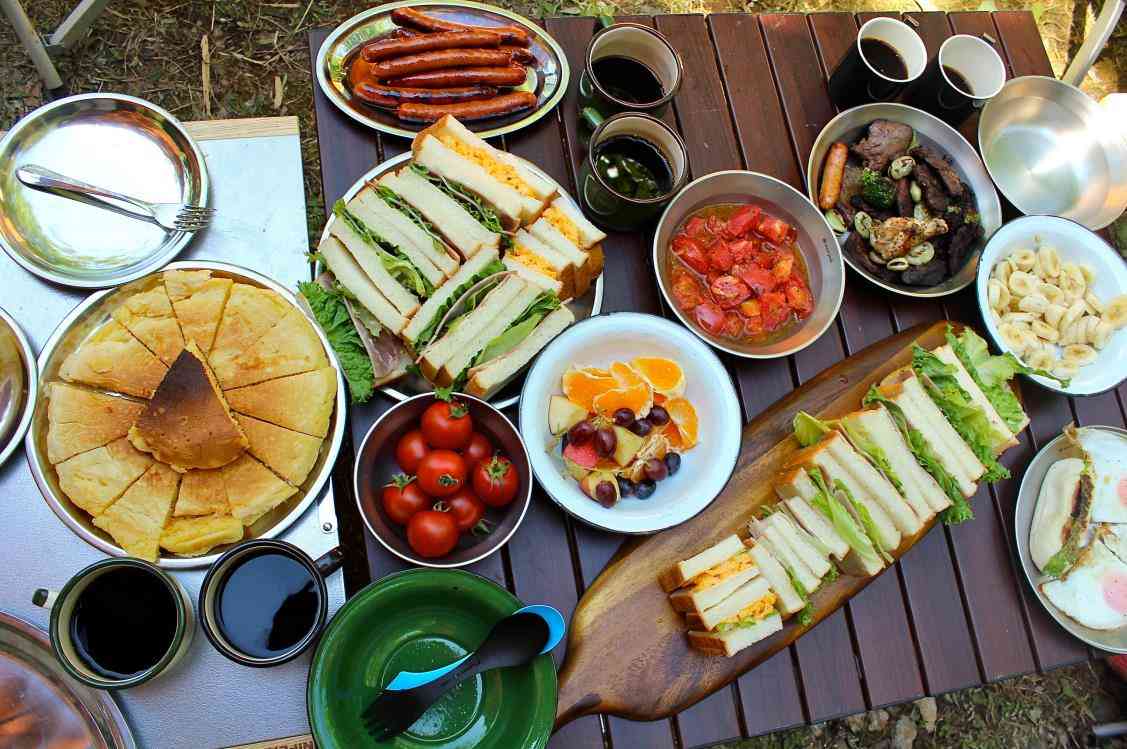
Below are some meals you can prepare if you decide to go out camping.
- Campfire sandwiches: Prepare some bread, and fillings like cheese, meat, and vegetables, wrap them in foil and cook them over hot coals.
- Foil-wrapped potatoes: Wrap potatoes in foil and bake them over hot coals for an easy side dish.
- Breakfast skillet: Cook eggs, bacon, and potatoes in a skillet over a portable stove or campfire.
- S’mores: Roast marshmallows over the fire and make s’mores with graham crackers and chocolate.
- Sandwiches and wraps: Make sandwiches or wraps with fillings like tuna salad, chicken, and vegetables for a quick and easy meal.
- Skewers: Thread meat and vegetables onto skewers and cook them over the campfire or portable grill for a tasty and easy meal.
- Trail mix: Mix nuts, seeds, dried fruit, and chocolate for a healthy and satisfying snack.
Closing thoughts
Camp cooking is an excellent experience that lets you enjoy the outdoors while preparing meals. With the various cooking methods available, such as grilling, boiling, roasting, Dutch oven cooking, foil packet cooking, smoking, campfire cooking, and solar cooking, you can explore your culinary skills while in nature. Still, safety should always be a top priority when cooking in the great outdoors, so follow the safety tips outlined to ensure a safe experience.
If you want a quality camping knife, our HDMD store has a collection of high-quality, high-carbon knives. These handmade knives guarantee top-notch performance at a low price and come with several perks, like free shipping within the US.







